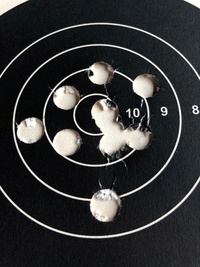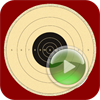Indoor targets are harder, here's why..
4 posters
Page 1 of 1
 Indoor targets are harder, here's why..
Indoor targets are harder, here's why..
1) Scaling
2) Hold quality
3) the range of errors you make
Lets look at these and see if l can explain properly.
Scaling: These 50 foot targets look harder, and depending on what you're shooting, they really are.
If you measure the diameter of the 50 or 25 yard center black, or any scoring rings, you'll find they don't seem to scale properly with distance to 50 feet; they scale out larger than the standard 50 foot rings. But in reality these three targets are all the same for size with regard to potential score.
If you consider the angle made by the centerline of a 45 bullet just clipping the 8 ring of both sides on a 50 yard target, ( A triangle from the gun to both centers) then theoretically, a 50 foot target placed in line would also have that 45 cal bullet just clipping the two extremes. If a 22 travelled the same paths, it would be 1 point lower. The 50 foot target therefore, is by definition harder to shoot with calibers under 45 and much more so with a 22.
Hold quality: If your sights are, and remain, aligned during your hold, ( not really true but think of the gun moving only from the shoulder) your gun can move up, down, left or right a couple inches on a 50 yd target and all other things equal, still score a 10. That amount of movement on a 50 footer, and you're in the white all around.
So a better hold (smaller wobble) is needed for shorter ranges.
Errors: Here runs the gamut of good and bad. 1) where were you pointing when the shot released ( assuming perfect trigger control) hi, lo, left right etc. Forget about the wheel of misfortune, it only works in reverse. Here's where calling your shot calling skills come into play.
Next, there's trigger induced motion (TIM) ON TOP OF where you might have been pointing. We all get those lucky tens now and then but usually it's low left (for right handers) or low riht (Lefty). This, in my opinion, is the worst error you can make and in this case, it makes the 50 yard target harder because angular errors increase with distance.
So it's yes and no on difficulty, the long line requires better trigger control but permits larger wobble. The 50 foot requires a much better hold and but more forgiving on angular error, however you got it.
Bullet diameter is a player. 45 is king of CF at 50 feet, or at least it's optimized. 38s for CF here are slightly disadvantaged. Tradeoff is recoil management in RF. At 25 yards there is favor for a 38.
A 22 is a 22, and we're all equal there.
Sorry for the long wheeze, but I hope this stimulates thought.
2) Hold quality
3) the range of errors you make
Lets look at these and see if l can explain properly.
Scaling: These 50 foot targets look harder, and depending on what you're shooting, they really are.
If you measure the diameter of the 50 or 25 yard center black, or any scoring rings, you'll find they don't seem to scale properly with distance to 50 feet; they scale out larger than the standard 50 foot rings. But in reality these three targets are all the same for size with regard to potential score.
If you consider the angle made by the centerline of a 45 bullet just clipping the 8 ring of both sides on a 50 yard target, ( A triangle from the gun to both centers) then theoretically, a 50 foot target placed in line would also have that 45 cal bullet just clipping the two extremes. If a 22 travelled the same paths, it would be 1 point lower. The 50 foot target therefore, is by definition harder to shoot with calibers under 45 and much more so with a 22.
Hold quality: If your sights are, and remain, aligned during your hold, ( not really true but think of the gun moving only from the shoulder) your gun can move up, down, left or right a couple inches on a 50 yd target and all other things equal, still score a 10. That amount of movement on a 50 footer, and you're in the white all around.
So a better hold (smaller wobble) is needed for shorter ranges.
Errors: Here runs the gamut of good and bad. 1) where were you pointing when the shot released ( assuming perfect trigger control) hi, lo, left right etc. Forget about the wheel of misfortune, it only works in reverse. Here's where calling your shot calling skills come into play.
Next, there's trigger induced motion (TIM) ON TOP OF where you might have been pointing. We all get those lucky tens now and then but usually it's low left (for right handers) or low riht (Lefty). This, in my opinion, is the worst error you can make and in this case, it makes the 50 yard target harder because angular errors increase with distance.
So it's yes and no on difficulty, the long line requires better trigger control but permits larger wobble. The 50 foot requires a much better hold and but more forgiving on angular error, however you got it.
Bullet diameter is a player. 45 is king of CF at 50 feet, or at least it's optimized. 38s for CF here are slightly disadvantaged. Tradeoff is recoil management in RF. At 25 yards there is favor for a 38.
A 22 is a 22, and we're all equal there.
Sorry for the long wheeze, but I hope this stimulates thought.
Bullseye58 and sbtzc like this post
 Re: Indoor targets are harder, here's why..
Re: Indoor targets are harder, here's why..
I shoot two indoor ranges in the winter. One is 50 feet, one is 25 yards, Scores are always better at 25 yards. Both rimfire and Center Fire.
David
David

David R- Posts : 408
Join date : 2018-12-10
Age : 64
Location : Hamlin NY
 Re: Indoor targets are harder, here's why..
Re: Indoor targets are harder, here's why..
Have you seen this?
http://indecorous.com/bullseye/rings.html
http://indecorous.com/bullseye/rings.html

-TT-- Posts : 624
Join date : 2016-10-18
 Re: Indoor targets are harder, here's why..
Re: Indoor targets are harder, here's why..
I have not but will read it when I have time.-TT- wrote:Have you seen this?
http://indecorous.com/bullseye/rings.html
One good test is to compare group size/scores at different distances to disgnose areas for study and improvement.
One fellow always beat me at 50 yards SF but seldom at 50 feet. He had better trigger control but l had, at that time ( when l got indoor 870-880s) a better hold.
 Re: Indoor targets are harder, here's why..
Re: Indoor targets are harder, here's why..
Our winter indoor scores are always lower than the norm but that's because there's NO HEAT! You would think if you can't feel your trigger finger that it would help mentally disconnect from sight alignment. All it does is put a bunch of holes in the ceiling in sustained fire.

inthebeech- Posts : 657
Join date : 2012-03-17
Age : 59
Location : Harleysville, Pennsylvania
 Similar topics
Similar topics» Show your targets. Any targets - For instance, First target, or one that shows progress, etc.
» Indoor Matches
» New Indoor Load
» NRA Indoor breakdowns
» .22 NRA Indoor Sectionals
» Indoor Matches
» New Indoor Load
» NRA Indoor breakdowns
» .22 NRA Indoor Sectionals
Page 1 of 1
Permissions in this forum:
You cannot reply to topics in this forum